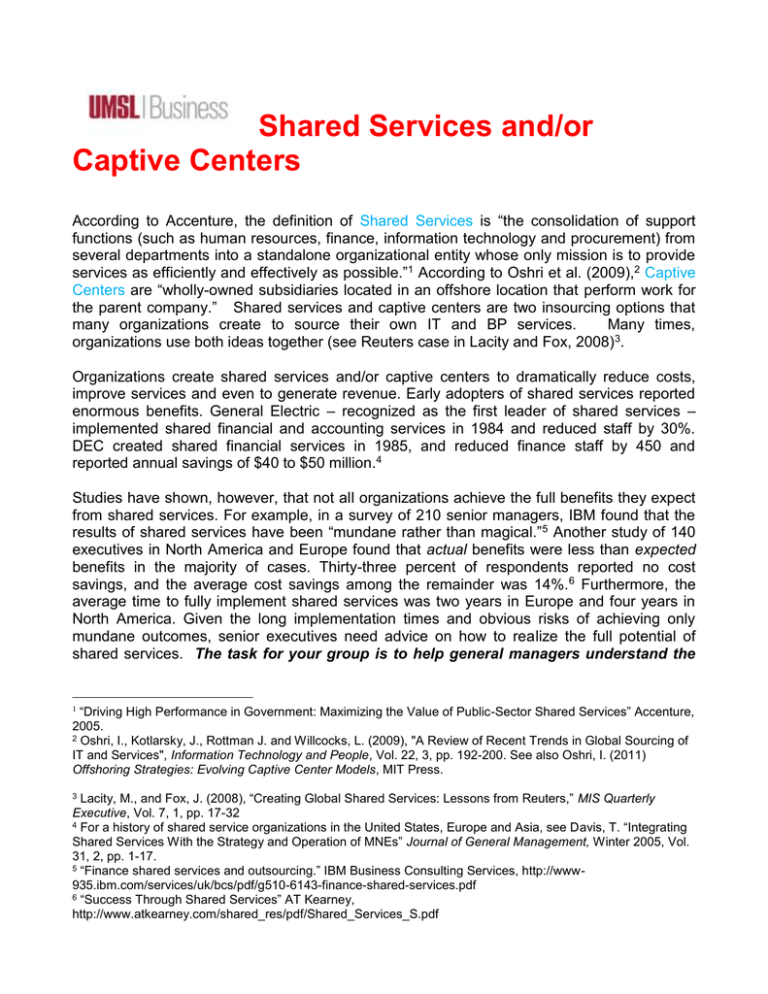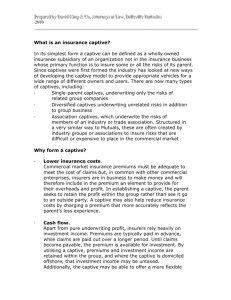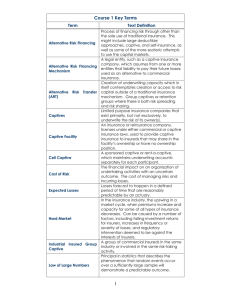Shared Services or Captive Centers
advertisement

Shared Services and/or Captive Centers According to Accenture, the definition of Shared Services is “the consolidation of support functions (such as human resources, finance, information technology and procurement) from several departments into a standalone organizational entity whose only mission is to provide services as efficiently and effectively as possible.”1 According to Oshri et al. (2009),2 Captive Centers are “wholly-owned subsidiaries located in an offshore location that perform work for the parent company.” Shared services and captive centers are two insourcing options that many organizations create to source their own IT and BP services. Many times, organizations use both ideas together (see Reuters case in Lacity and Fox, 2008)3. Organizations create shared services and/or captive centers to dramatically reduce costs, improve services and even to generate revenue. Early adopters of shared services reported enormous benefits. General Electric – recognized as the first leader of shared services – implemented shared financial and accounting services in 1984 and reduced staff by 30%. DEC created shared financial services in 1985, and reduced finance staff by 450 and reported annual savings of $40 to $50 million.4 Studies have shown, however, that not all organizations achieve the full benefits they expect from shared services. For example, in a survey of 210 senior managers, IBM found that the results of shared services have been “mundane rather than magical.”5 Another study of 140 executives in North America and Europe found that actual benefits were less than expected benefits in the majority of cases. Thirty-three percent of respondents reported no cost savings, and the average cost savings among the remainder was 14%. 6 Furthermore, the average time to fully implement shared services was two years in Europe and four years in North America. Given the long implementation times and obvious risks of achieving only mundane outcomes, senior executives need advice on how to realize the full potential of shared services. The task for your group is to help general managers understand the “Driving High Performance in Government: Maximizing the Value of Public-Sector Shared Services” Accenture, 2005. 2 Oshri, I., Kotlarsky, J., Rottman J. and Willcocks, L. (2009), "A Review of Recent Trends in Global Sourcing of IT and Services", Information Technology and People, Vol. 22, 3, pp. 192-200. See also Oshri, I. (2011) Offshoring Strategies: Evolving Captive Center Models, MIT Press. 1 Lacity, M., and Fox, J. (2008), “Creating Global Shared Services: Lessons from Reuters,” MIS Quarterly Executive, Vol. 7, 1, pp. 17-32 4 For a history of shared service organizations in the United States, Europe and Asia, see Davis, T. “Integrating Shared Services With the Strategy and Operation of MNEs” Journal of General Management, Winter 2005, Vol. 31, 2, pp. 1-17. 5 “Finance shared services and outsourcing.” IBM Business Consulting Services, http://www935.ibm.com/services/uk/bcs/pdf/g510-6143-finance-shared-services.pdf 6 “Success Through Shared Services” AT Kearney, http://www.atkearney.com/shared_res/pdf/Shared_Services_S.pdf 3 promises, pitfalls, and best practices associated with shared services and or captive centers. Your presentation may begin by answering these questions: Did you choose to study shared services or captive centers or both? Why? How big is the phenomenon today and how big is projected to be? What type of services are typically offered through shared services and/or captive centers? What are the real risks to a client company as opposed to perceived risks in creating shared services and/or captive centers? Who are some of the model companies in this space? (Such as winners of shared service awards) Your presentation should proceed with one to three case studies of organizations' with shared services and or a captive center. Case studies should include the Company Background: Size of company in terms of sales and profits & number of employees Major products the company sells The main part of the case should be a retelling of the shared services/captive center story at each company. (See questions to ask interviewees below). The group should end the presentation by comparing the cases and providing some best practices or important lessons for general managers. If you have other creative ideas, please feel free to discuss them with me. Potential questions for interviewees: Please tell us a little bit about your current job and the role you play or played in outsourcing: Job title Length of time in current position Role in shared services/captive center decision, implementation, and/or management Please tell us your shared services/captive center story—when and why did your organization decide to create shared services (and/or erect a captive center)? Did your organization ever consider outsourcing this to a provider? Who were the senior leaders in charge of shared services? What was the scope of work initially? Functionality Number of workers Contract value Contract duration TRANSITION PHASE: How was work initially moved to shared services/captive center? How were people initially recruited/transferred to shared services/captive center? What were the two to three things you did well to successfully transition work to the shared services/captive center? What were the two to three things you could have done better in transitioning work? What were the two to three things the shared services/captive center did well initially? What were the two to three things the shared services/captive center could have done better initially? DELIVERY PHASE: Since the initial transition period, what has changed in terms of: Scope of work Quality of deliverables Processes used to assign, review, and accept work from internal clients to shared services/captive center People assigned as liaisons or contacts How does your organization resolve conflicts or misunderstandings between internal clients and shared services/captive center? Please describe your governance process including performance metrics, service level agreements, chargeback mechanisms, etc. OUTCOMES OVERALL: Overall, to what extent is your organization getting the cost savings from shared services/captive center it expected to get? Overall, to what extent is your organization getting the quality of work from shared services/captive center it expected to get? LESSONS LEARNED: What advice would you give to another company interested in creating shared services/captive center? What are the three critical success factors in creating shared services/captive center? The best book on Captive Centers is: Oshri, I. (2011), Offshoring Strategies: Evolving Captive Center Models, MIT Press, Cambridge Massachusetts. I will post some Shared Services references in mygateway.







